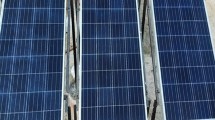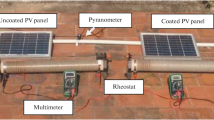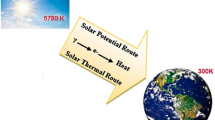Abstract
This work aims at developing reliable solar technologies for regions characterized by hot climate and with high dust density, which are considered as significant constraints to the development of high-performance photovoltaic systems in the Middle East and North Africa (MENA) regions. After reviewing actual technologies to solve these issues in MENA region, where water is considered a precious resource, a proposal to apply a nanocoating on photovoltaic panels in a simple and cost-effective way is examined. Experimentations realized under control of optical and electrical benches revealed a considerable gain in light transmission and open circuit voltage, respectively. A thermoelectric analysis demonstrated that nanocoated photovoltaic (PV) modules are running cooler than untreated ones. This behavior is due to hot spot caused by shading effects of dusts in case of uncoated PV panels. The tested hydrophobic coating layer reduces these issues and solves the problems of dust and electrical losses.












Similar content being viewed by others
References
Bai N, Li Q, Dong H, Tan C, Cai P, Xu L (2016) A versatile approach for preparing self-recovering superhydrophobic coatings. Chem Eng J 293:75–81
Barthlott W, Neinhuis C (1997) Purity of the sacred lotus, or escape from contamination in biological surfaces. Planta 202:1–8
Böer WPK (2013) Handbook of the physics of thin-film solar cells. Springer, Berlin
CeNano (2016) http://www.cenano.de. Accessed 30 Mar 2016
Cucchiella F, D’Adamo I (2015) Residential photovoltaic plant: environmental and economical implications from renewable support policies. Clean Technol Environ Policy 17:1929–1944
Darwish ZA, Kazem HA, Sopian K, Al-Goul MA, Alawadhi H (2015) Effect of dust pollutant type on photovoltaic performance. Renew Sustain Energy Rev 41:735–744
Deutsche Gesellshaft Für Sonnenenergie (2008) Planning and installing photovoltaic systems: a guide for installers, architects and engineers, 2nd edn. Earthscan Publications Ltd, Routledge
Elnozahy A, Abdel-Rahman AK, H-Ali AH, Abdel-Salam M, Ookawara S (2015) Performance of a PV module integrated with standalone building in hot arid areas as enhanced by surface cooling and cleaning. Energy Build 88:100–109
Gaier J, Davis P (1992) Effect of particle size of Martian dust on the degradation of photovoltaic cell performance. NASA TM-105232
Gaier J, Davis P, Marabito M (1990) Aeolian removal of dust types from photovoltaic surfaces on Mars. 16th AIAA/NASA/ASTM/IES Space Simulation Conference. NM: Albuquerque
George JE, Rodrigues VRM, Mathur D, Chidangil S, George SD (2016) Self-cleaning superhydrophobic surfaces with underwater superaerophobicity. Mater Des 100:8–18
Giolando DM (2016) Transparent self-cleaning coating applicable to solar energy consisting of nano-crystals of titanium dioxide in fluorine doped tin dioxide. Sol Energy 124:76–81
Goetzberger A, Knobloch J, Bernhard V (1998) Crystalline Silicon Solar Cells. Wiley, Chichester, p 116
He G, Zhou C, Li Z (2011) Review of self-cleaning method for solar cell array. Procedia Eng 16:640–645
Jones RK, Baras A, Al-Saeeri A, Al-Qahtani A, Al-Amoudi AO, Al Shaya Y, Alodan M, Al-Hsaien SA (2016) Optimized cleaning cost and schedule based on observed soiling conditions for photovoltaic plants in central Saudi Arabia. IEEE J Photovolt 6:730–738
Kawamoto H, Shibata T (2013) Electrostatic cleaning system for removing sand on solar panels. 39th IEEE Photovoltaic Specialist Conference, 94–98
Kawamoto H, Shibata T (2015) Electrostatic cleaning system for removal of sand from solar panels. J Electrostat 73:65–70
Khalilzadeh A, Fatemi S (2014) Modification of nano-TiO2 by doping with nitrogen and fluorine and study acetaldehyde removal under visible light irradiation. Clean Technol Environ Policy 16:629–636
Krarti M, Ihm P (2016) Evaluation of net-zero energy residential buildings in the MENA region. Sustain Cities Soc 22:116–125
La Russa MF, Rovella N, De-Buergo MA, Belfiore CM, Pezzino A, Crisci GM, Ruffolo SA (2016) Nano-TiO2 coatings for cultural heritage protection: the role of the binder on hydrophobic and self-cleaning efficacy. Prog Org Coat 91:1–8
Lin Y-C (2013) Applying Ag–TiO2/functional filter for abating odor exhausted from semiconductor and opti-electronic industries. Clean Technol Environ Policy 15:359–366
Lopez-Garcia J, Pozza A, Sample T (2016) Long-term soiling of silicon PV modules in a moderate subtropical climate. Sol Energy 130:174–183
Maghami MR, Hizam H, Gomes C, Radzi MA, Rezadad MI, Hajighorbani S (2016) Power loss due to soiling on solar panel: a review. Renew Sustain Energy Rev 59:1307–1316
Nanotol (2016) https://www.nanotol.de/en/online-shop/nano-coating-for-glass/. Accessed 25 May 2016
Nomad (2016) http://www.nomaddesertsolar.com/faq.html. Accessed 04 Apr 2016
Ortore E, Francione V (2008) On the aerosols monitoring by satellite observations. Clean Technol Environ Policy 10:137–145
Parajuli SP, Yang ZL, Lawrence DM (2016) Diagnostic evaluation of the community earth system model in simulating mineral dust emission with insight into large-scale dust storm mobilization in the middle east and North Africa (MENA). Aeolian Res 21:21–35
Paranthaman MP, Wong-Ng W, Bhattacharya RN (2016) Semiconductor materials for solar photovoltaic cells, 1st edn. Springer International Publishing, Switzerland
Perez MD, Gorji NE (2016) Modeling of temperature profile, thermal runaway and hot spot in thin film solar cells. Mater Sci Semicond Process 41:529–534
Petrakopoulou F (2014) Study of different cleaning methods for solar reflectors used in csp plants. Energy Convers Manag 118(15):63–74
Schneck A (2009) Bounds for optimization of the reflection coefficient by constrained optimization in Hardy spaces. KIT Scientific Publishing, Karlsruhe
Shahin T (2013) New Energy Oasis (NEO)-Desert Solar at KAUST King Abdullah University. http://saudi-sia.com/wp-content/uploads/2013/05/7-Tamer-Sahin-NEO-Presentatin_SolarPlaza.pdf
Shirgholami MA, Nazari A, Mirjalili M (2015) Statistical optimization of self-cleaning technology and color reduction in wool fabric by nano zinc oxide and eco-friendly cross-linker. Clean Technol Environ Policy 17:905–919
Snieder R (2004) A guided tour of mathematical methods: for the physical sciences, 2nd edn. Cambridge University Press, Cambridge
Solheim HJ, Fjær HG, Sorheim EA, Foss SE (2013) Measurement and simulation of hot spots in solar cells. Energy Procedia 38:183–189
Sze SM (1981) Physics of Semiconductor Devices, 2nd edn. Wiley, New York
Williams RB, Tanimoto R, Simonyan A, Fuerstenau S (2007) Vibration characterization of self-cleaning solar panels with piezoceramic actuation. Collection of Technical Papers-48th AIAA/ASME/ASCE/AHS/ASC Structures, Structural Dynamics, and Materials Conference, 512–520
Xiao S, Xu S, Wang X, Wang ZM (2014) High-efficiency solar cells: physics, materials, and devices. Springer International Publishing, Switzerland
Yao L, He J (2014) Recent progress in antireflection and self-cleaning technology—From surface engineering to functional surfaces. Prog Mater Sci 61:94–143
Zhou C, Xiao H, Zhang J, Sun S (2015) The electric curtain method of dust removal and measurement of particle size and density on solar cells. Energy Environ Eng Chapter 7:33–37
Author information
Authors and Affiliations
Corresponding author
Rights and permissions
About this article
Cite this article
Fathi, M., Abderrezek, M. & Friedrich, M. Reducing dust effects on photovoltaic panels by hydrophobic coating. Clean Techn Environ Policy 19, 577–585 (2017). https://doi.org/10.1007/s10098-016-1233-9
Received:
Accepted:
Published:
Issue Date:
DOI: https://doi.org/10.1007/s10098-016-1233-9




